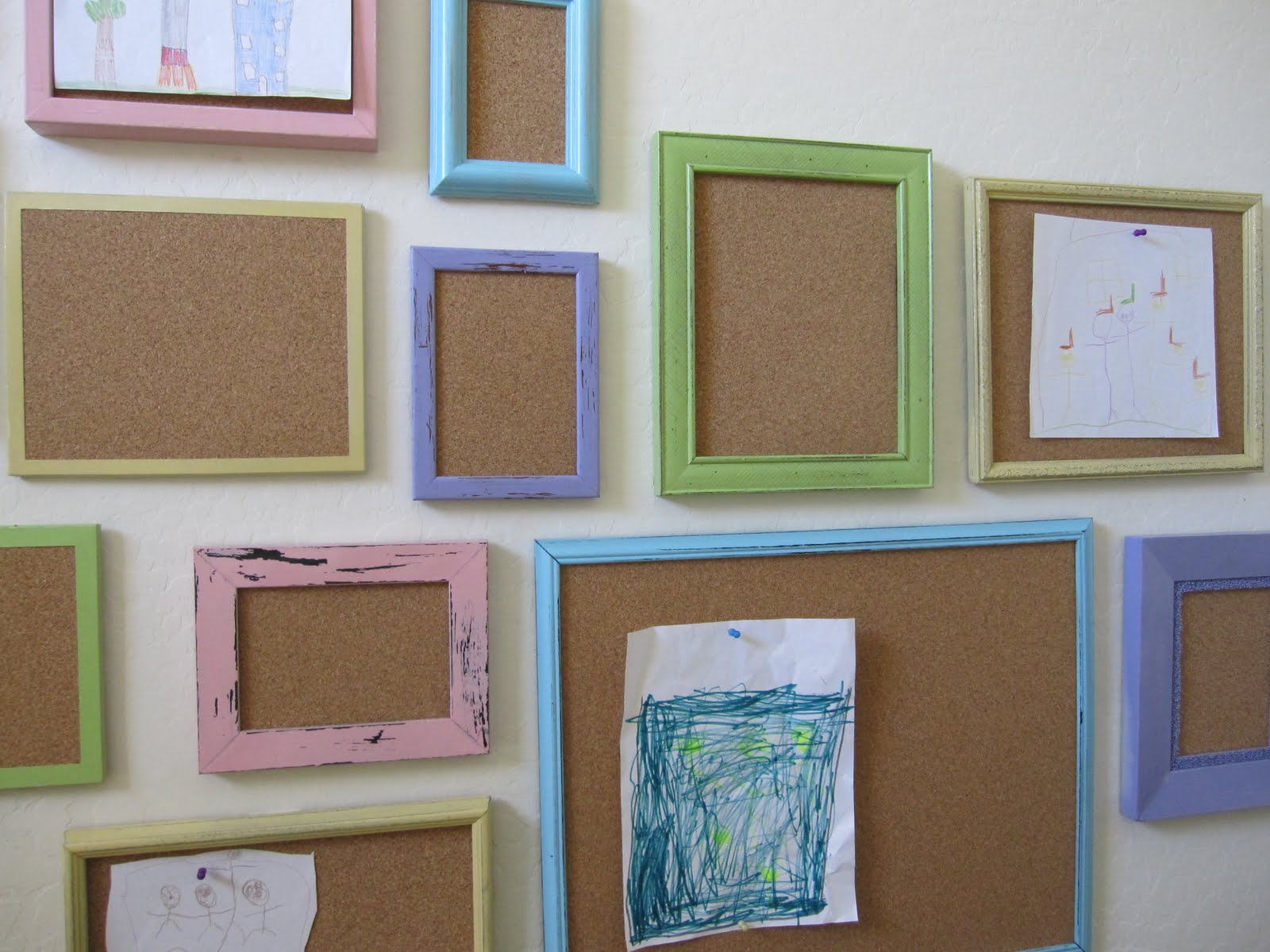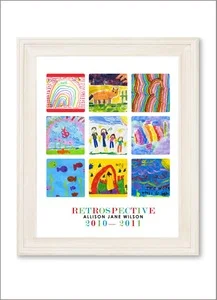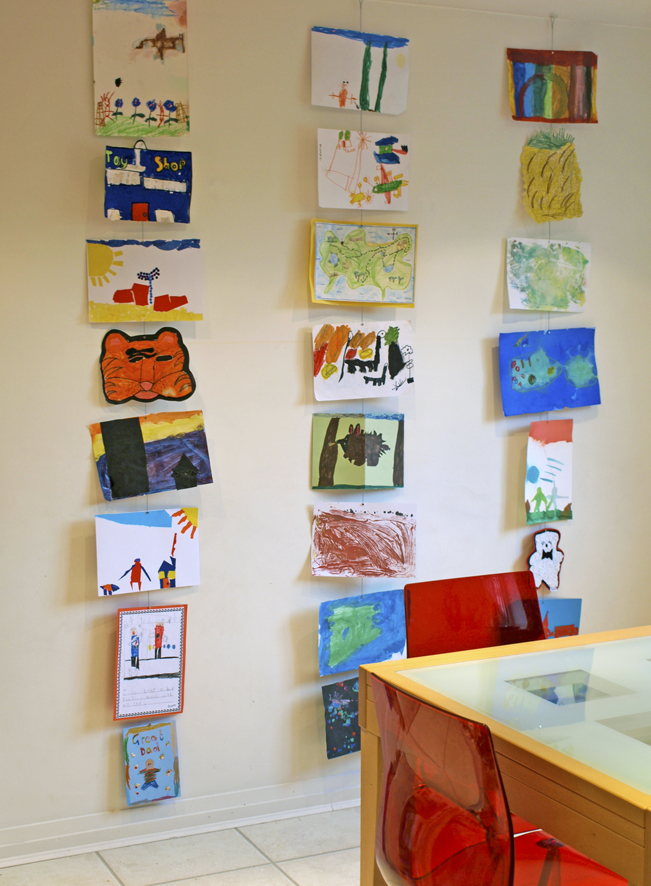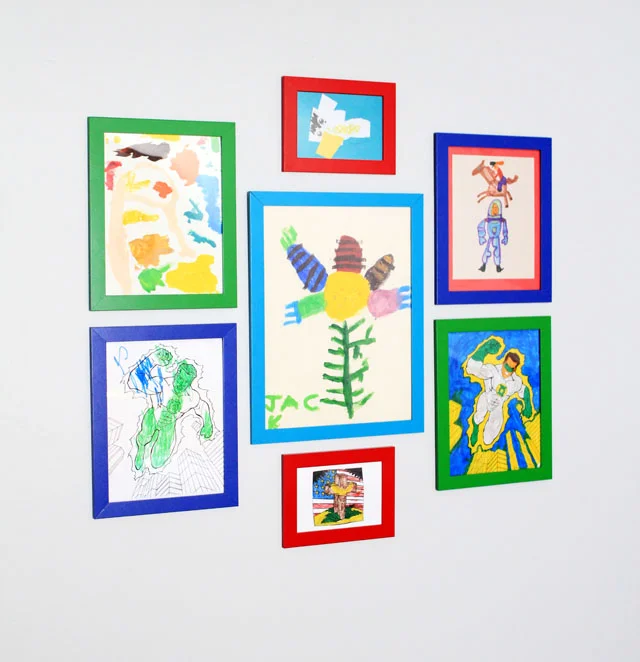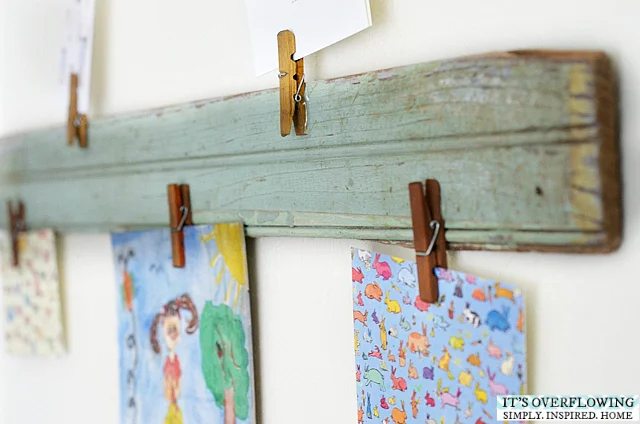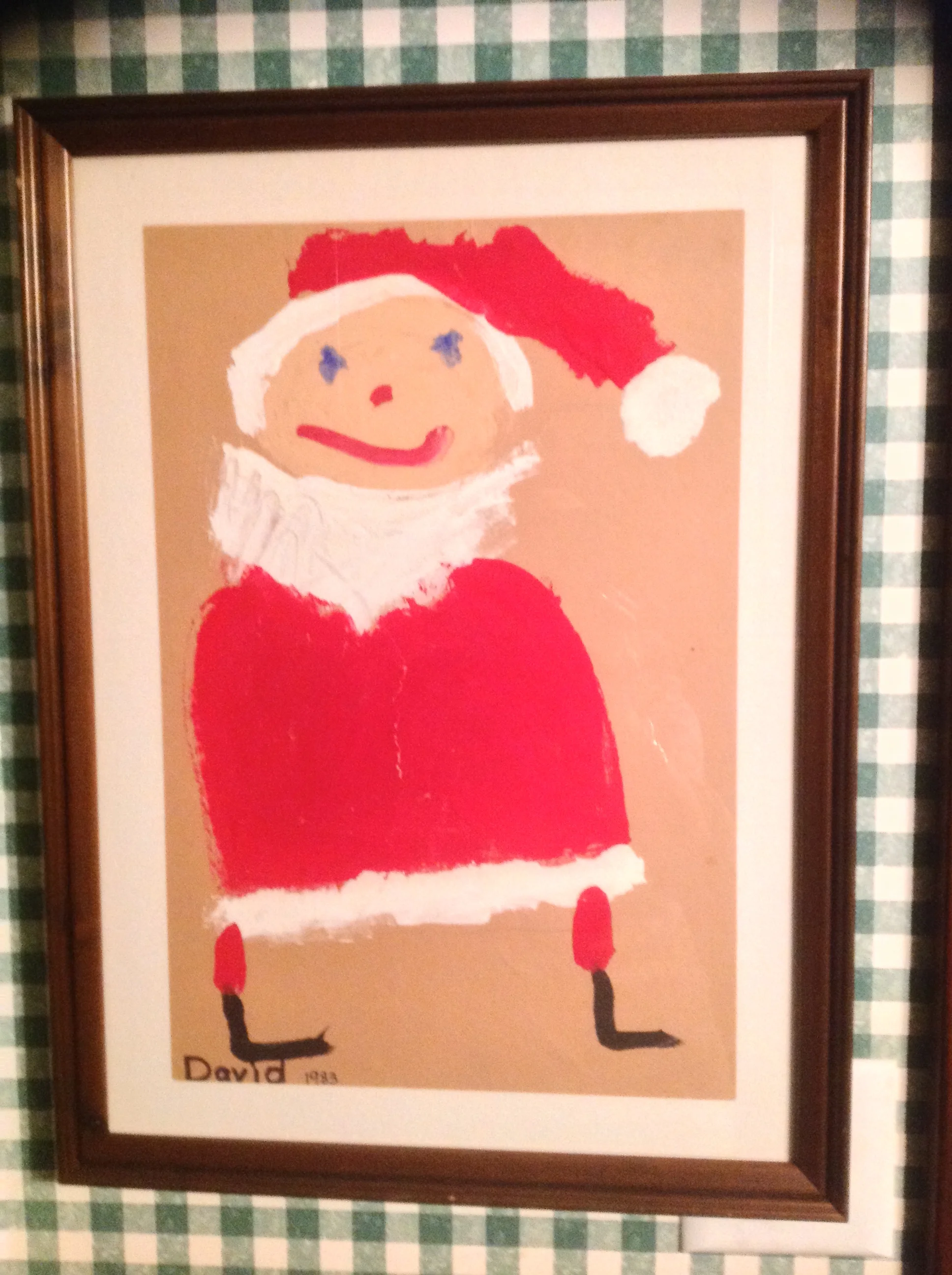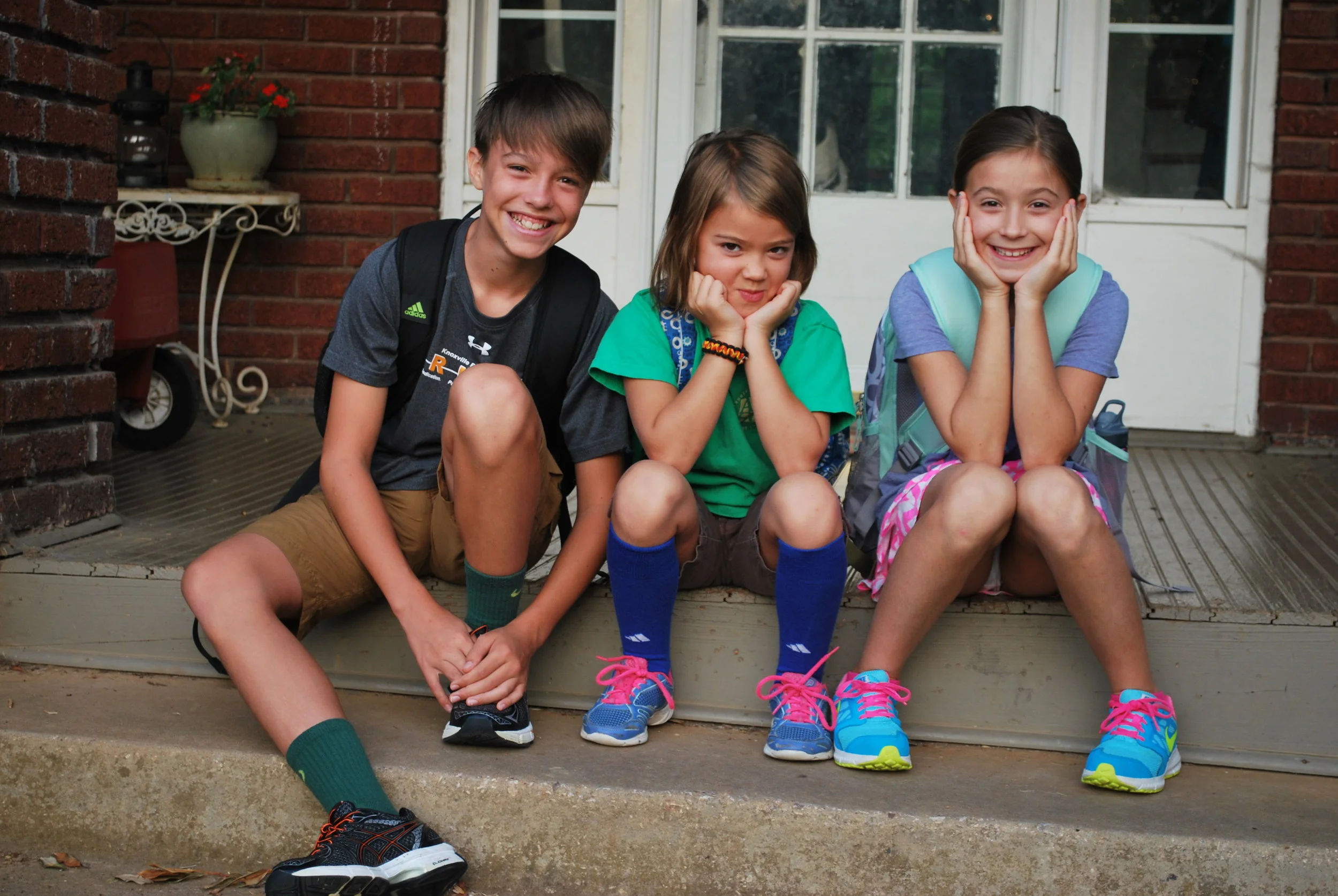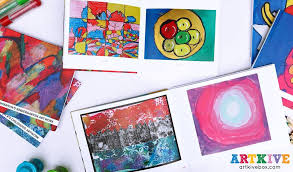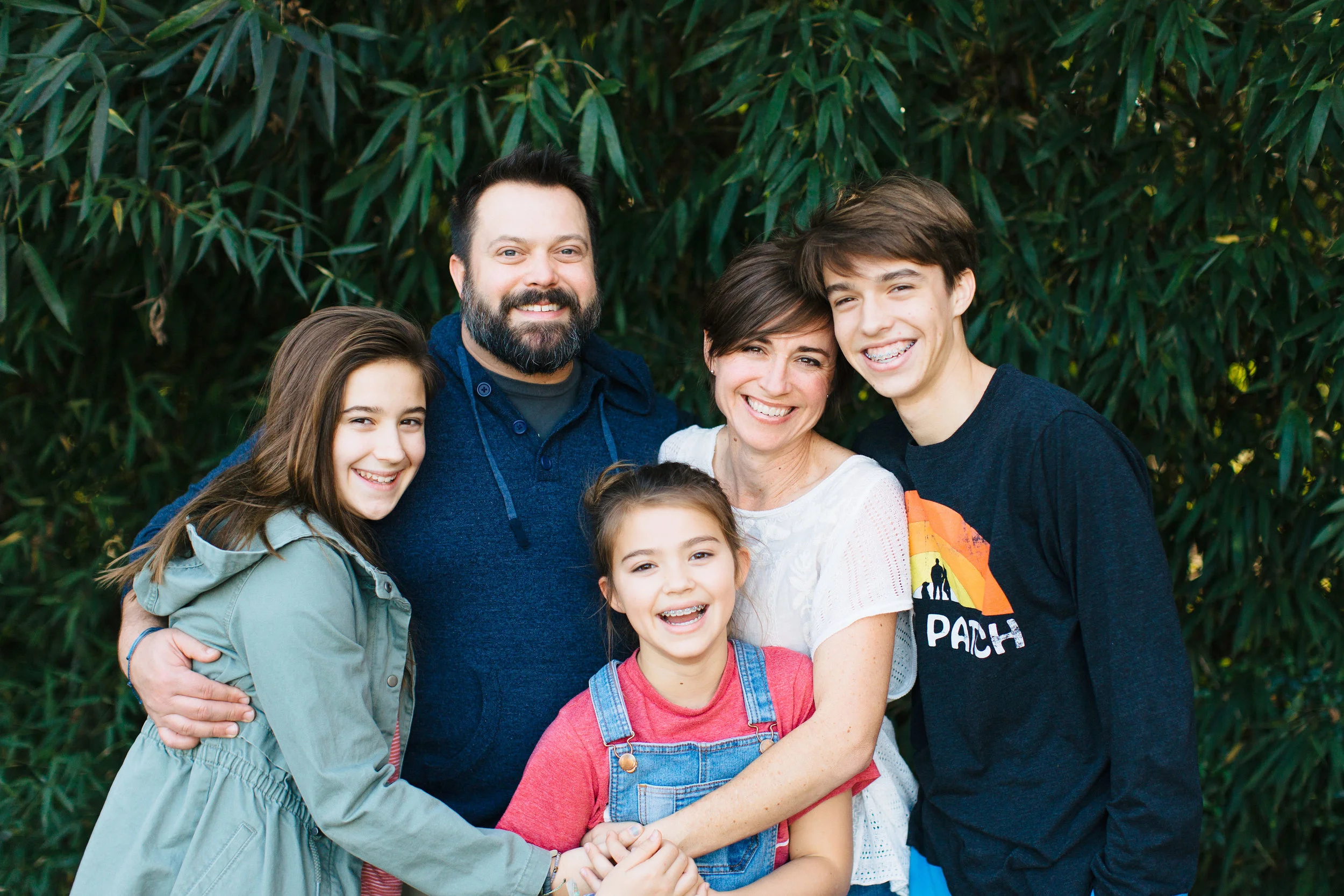If you’re not heading out of town for a trip during Knox County fall break, you will likely be spending a little more time than normal at home this week. We’ve put together some fun and creative ways to involve your kiddos in the organizing process at home.
The Tale of a Trader Joes Bag
10 Ways to Display Kids Artwork
10 Ways to Display Kids Artwork
We recently heard a neighbor friend say that her quarantine home looks like “a craft store exploded inside.” Can any of you with small kids else relate?? So, what should we do with all those newly created art masterpieces from our kiddos? We want to celebrate all their little creations!
Instead of just stashing all their art in a folder or adding it to "the pile," here are 10 creative & manageable ways to bring some color into your home, celebrate the seasons, & show off your kids' imagination through art.
1. Use tacks on a wall that's not front and central in your home.
So this first one's not rocket science, but it's what works in our home. Our laundry room is on the main level & has gray walls so the art can really pop! I (or my kids) just rotate their art 2-3 times a year in this room leaving tiny holes from the tacks. The way I look it, when the art stops coming home someday, I'll be ready to repaint the room anyway, but until then, I get to be reminded of these little people I love so much while I'm trying to find that missing sock or checking their pockets before they hit the washer.
Try these Push Pin Clips
2. Thrift frames with glass removed and cork board added.
This is a great option for a more polished look that keeps it super easy to rotate art. Shannon Makes Stuff has great images for ideas. Let the kids have another art project by painting the frames themselves.
Try this cork board.
3. Have Simply Create Kids create a collage poster of your child's art.
This option is a bit more pricey, but well worth the money to have one piece that speaks for many. My kids would love how professional this art display would make their art look.
4. Create vertical art on a string.
The folks at Artful-Kids used a hanging wire to display art vertically allowing for easy rotation. This is a great option if you're short on wall space.
Use this Hanging Picture Display Holder.
5. Use inexpensive IKEA frames in the color that work for your space.
We love how Amanda Medlin created this wall for her boys' room with multicolored frames, but all white or all black frames would be another great option to showcase your child's art.
6. Clothespins are great for art display.
Aimee of It'sOverflowing.com has a great DIY plan to create a fun clothespin line for your kids to be able to change their own art with ease. HYD helped a client design one similar to this last year & it was a huge hit with their four kids.
Try these mini clothes pins.
7. ArtKive it by photographing your child's art with your smartphone.
This is brilliant. ArtKive has designed an app that allows you to photograph the artwork, upload it, and then turn it into books, gifts, or keepsakes.
8. Mount clipboards to the wall.
HYD loves reclaimed wood projects. These from Old House to New Home are some of our favs. Of course, you could use lots of different styles of clipboards that work best for your space.
9. Professionally frame special holiday pieces.
My thoughtful mother decided to pick a couple of my brother's & my best Christmas creations. My brother's is a Santa with no arms, he's a beauty. I did a lovely manger scene that brings back memories but doesn't come close to the fine artistic ability of my brother. It's been over 30 years since we created them & every year, we reminisce & poke fun at each other when mom hangs them. I love them!
10. Keep it simple with a line of twine.
Nothing too fancy here. Just find a color of twine or string that works for your space & use clothespins, paper clips, or even colorful hair clips to hang the art. The image above is our favorite using the spools as the anchors to hang. I have a friend who uses the twine method above her kitchen sink with smaller art pieces & it's so cute. She uses her childs' art in lieu of a curtain valance.
Get some twine here.
We hope you find these ideas helpful!
Do you have an art wall that works in your house? We'd love to hear how you're showing off your kids' art.
Read some more helpful blogs dwelling well with kiddos!
5 Tips for the Back to School Routine
One thing I love about a new school year is, it’s new. We begin the year with all As, we get fresh notebooks, new teachers, and get to start again. It’s also a great time to adopt a few new habits surrounding the school routine to help stay on top of the schedule, the clutter, the schoolwork, and to encourage your kids to have their best year yet. We’ve compiled a few tips to get your year off on the right foot!
5 Tips to Streamline the Back to School Routine!
Image: Magnolia
1 . An Established Landing Space
This will look different in every home, entirely dependent on your home’s layout. This is an area that should be relatively close to the entry and exit point used each morning. Landing spaces can be useful to collect bookbags and store to-do baskets. Think of this as the command center of the morning on the way out the door. Check out this blog by Joanna Gaines for tips on how locker baskets can be used in your landing space!
2 . Routine Checklists for the Littles
Printable checklists ( laminated or put behind a glass for use with a dry erase ) can be so helpful to guide littles along their new morning routines, this gives them a sense of ownership of their morning and you can still be directly involved to keep them on track.
*We’ve created these two printable options as a framework to your morning routine!
3. Streamlined Schedules for the Big Kids
For kiddos that aren’t exactly kiddos anymore, a virtual approach could keep the entire family on board the same ship! Google calendar app can be a great option for synchronizing sports schedules, events, and the heavier after school schedule that the teen sports/club years can come with.
Another option is a centralized large chalkboard or dry erase calendar in the home. This is a great addition to the landing space or command center and can be a great reminder when headed in or out the door each day. There are definitely pros and cons to each calendaring options, find what works best for your people.
4 . Art & Schoolwork Management
A great habit to adopt for school work brought home is “touch it once!” If the assignment is a worksheet or test from class that has no emotional connection to your child, and your child is ready to let go, after acknowledgment of their efforts and skill they now have by doing the practice, it goes to the recycle bin immediately.
As for artwork, a great rule of thumb for what to keep is to see if you can see the unique work of your own child in each piece. Once that decision is made, a clear Rubbermaid tote with your child’s name and school year(s) can be used if originals want to be kept.
Another option we love is ARTKIVE. ARTKIVE lets you send in all the originals to be professionally photographed and bound into a hardback book or a framed piece!
Image: Home Stories A to Z
5 . Designated Homework Areas
This can be such a stress reliever in many ways encouraging productivity, organization, and quality of work. Establishing a homework zone can communicate the same thing to a child as “going to the office” can for an adult. You set the tone for their work flow and focus by designating study areas. This can be as simple as a lazy susan with cups of supplies easily moved to the middle of a table, or as established as a study nook in the home. Wherever the investment, the reward will be worth it!
Start 'em young
Taryn with Kate, Will, and Eli Ruth // 2008
I became a mom with very few plans in place for how I’d spend time with my child or children, how I envisioned my home being set up for little ones, or how many kids I wanted to have. I’d always hoped to be a mom. I just didn’t really have specific ideas of exactly how that might go down. Almost 17 years into motherhood, and 3 amazing kids later, I am both thankful for that somewhat clueless beginning and at the same time, a bit regretful that I wasn’t more intentional.
Image: Texture Photo // 2018
I’ve found that not having concrete expectations of how motherhood would go was a gift in that it allowed for a whole lotta grace. Not so much pressure on them or on me to be someone I had dreamed up in my head. I think I have been able to pay closer attention to each one of my kids and their unique personalities, ways of relating, and specific needs better since I didn’t have rigid expectations of what I wanted parenting and my kids to look like.
Being somewhat clueless also paved the way for new relationships and a sweet reliance on family. I am fortunate to have started motherhood off with some incredible new mamas who I’ve shared this crazy adventure with and who are still some of my dearest friends. We learned so much from one another. I am also a very blessed gal to have a mom and mother-in-law who have shown me what great love and sacrifice for your kids looks like. All good gifts in the midst of my cluelessness.
However, there is one area that I do wish I had been more thoughtful about at an earlier stage — how to create spaces in my home, and spaces in our days, for my kids. I had to make a lot of mistakes in this area before realizing there’s a better way. Of course hindsight is 20/20, but if I had taken a bit more time to think through what items &/or areas in my home that would encourage my kids to learn, explore, and love well, I would’ve saved myself lots of hours of singing (and doing) the “clean-up, clean-up, everybody everywhere” song and dance, procrastination, guilt, and frustration.
On May 2 at The Back Porch Mercantile, this is the exact topic we will be teaching on.
How do we get a baby’s room ready with all the needs but not the excess?
What’s the best way to create a play area for toddler’s that allows them to explore but doesn’t turn my house into a plastic toy jungle?
Do I keep all my preschooler’s handprint art and the other 724 pieces of art they’ve created?
Toys through the years and how to store them in a way that your kids can actually clean them up.
How do we do birthdays and holidays well without filling up on too many gifts?
What to do with all my elementary-age child’s school work?
How do teach my kids to organize?
I have learned lots raising this boy and my two girls. I’m still learning. And whether you’re a new mom or a few years in, my hope for you is that through some intentional, thoughtful planning, you can create the best space for your kids and for you to be the best mom you can be.
summer survival tips
School's out for summer...The kids across Knox County are cheering for full days of play and fun, while parents have a new duty of planning summer activities and being prepared for whatever the fun days might hold! Here are a few ideas to help you be extra prepared:
Image via Yummy Mummy Club blog.
- In the car...
You never know what you (or your various passengers) might need. This pop up organizer has a place for everything. Consider keeping the following items on hand: paper towels, bandaids, umbrella, trash bag, activity books, bungee cords, sunscreen, nonperishable snack, and a beach towel.
- In the garage...
Coming home from trips, pool days or picnics - the garage sometimes becomes the landing place for these items. Having a trash can and recycle bin will help with efficiently clearing out the trash before taking bags into the house. Keeping Clorox wipes near by to wipe out coolers after being used, will keep them from getting nasty over time. Make it a priority to always wash the wet bathing suits & towels from a trip immediately. Rinsing off any items with sand or dirt on them will save you from future mess!
Image via Market Square Farmer's Market instagram.
- In the kitchen...
It seems like everyone is snacking more than ever in the summer. After a successful trip to the Farmer's Market, fill up a bowl with your fruit for anyone to grab on the go. Granola bars, PB&J, hummus, nuts are great snacks to grab on the run. If you have kids, designate areas for their snacks and drinks, separate from what you are using to cook meals to avoid confusion or clutter. Having paper products for an impromptu picnic will allow you to spontaneously decide to take your meal outdoors, and provides a quick and easy clean up.
Keys to a Peaceful Summer
A big hooray for students, teachers, volunteers and parents who worked hard this school year!
Kids have been counting down the days; eagerly awaiting pool play time, road trips, and freedom to roam the neighborhood day & night. While summertime is sweet it can also add some chaos to our homes and cars. Here are a few tips to keep peace in your home & car this summer while the fun summer activities ensue!
Fill a small tote with the summer outdoor essentials and keep it in your garage or laundry room (easy access to grab and go). Fill it with these items: outdoor/picnic blanket, sunscreen, bug spray, band aids, frisbee, and the ever useful Eno hammock.
Designate a section of the pantry and refrigerator for kids snacks and drinks. Make sure to pick an easily accessible shelf for your kiddos. These snacks and drinks will take up more room in the summer than they do during the school year, so it saves everyone from clutter and hunting for the right snack to designate a specific shelf.
Plan some free family fun - check out these local hikes from Outdoor Knoxville. Be sure to check the weather forecast, grab some snacks & hit the trail together. This is a great alternative to more expensive indoor activities. You could even incentivize the hike by allowing your kids to invite a friend if they consistently keep up with their chores around the house for a week straight!
Check out the Children's Festival of Reading hosted by the Knox County Public Library. This Saturday, May 21 is the free kick off event at 10:00 AM! The library is a great resource to continue education and reading throughout the summer, especially on those rainy days.
Happy summer to you!
Organizing Kids Rooms
Playrooms and kids' rooms are often some of the hardest spaces to organize. Finding a good balance of knowing when the toys are taking over but also keeping a wide range of options to foster creativity and fun is a challenge. Organizing for kids is a hard task. While respecting what an individual child enjoys playing with, there are ways to purge without ending up with lots of tears over toys that are missed.
1. Talk with your kids about what happens to toys that they let go of. Help them see the story that they play a part in when they donate toys to children that may not have toys to play with like they do. If you have a child that gets excited to participate in the process of purging, let them be a part of the process. Ask them which toys they would like to share with a less fortunate child.
2. If your child isn't as willing to let go of things, take a few weeks to intentionally notice what toys they spend the most time playing with and which toys are neglected, or maybe they have grown out of. For children less willing to purge when the toys are taking over, try boxing up all of the toys that you believe they are done with. Keep the box in a hidden location for two weeks and if they haven't noticed or don't seem to mind that the toy is gone, give it away. Concentrate on helping your children value relationships more than things.
3. Specific toys to keep: Try to keep toys that help foster creativity, furthering education, and thinking skills. Art and Craft supplies, dress up clothes, building blocks, games, etc.
4. If your kids share a room, help them make their own space feel special. Sometimes kids need their own space and sometimes they need to learn how to share space well. Whether your kids share a room or have their own, making an effort to hang their favorite poster, frame their best art creation(s), create a reading nook, or frame a photo of your child with their best friend can make them feel proud of their own space and, hopefully, lead to taking more responsibility of keeping it in order.
Photo: James Henry / bauersyndication.com.au
5. Kids clothes.
It's amazing how quickly kids grow out of their clothing. This is an ongoing process. Each season, go through each closet and toss or donate items that are worn out or no longer fit. If you have younger kids that will grow into things in the future, just keep the well maintained items & box up clothing by size and sex and store somewhere other than their closet if you have the storage space available. When it comes to kids closets, make sure items are stored in a way that makes it easy for them to become more independent. Can they reach the things they need to? Is it obvious where things go?
6. Kid storage.
Coming up with a way to organize toys and games that is conducive to kids can be complicated. Bins can be a great help as a solution. This unit has the ability to do both store in bins and on shelves which can be helpful with multiple shapes of toys. Getting items off the floor and onto shelves or in bins is a must.
7. Kids books. The best advice here is have lots to choose from on shelves that your kids can easily reach. Color coordinating can be a fun project for kids and is much more practical in re-shelving than alphabetically.
8. Art supplies. Which supplies do you want them to be able to access without you present? Which supplies do you only want used with adult supervision? This changes with age so reorganizing is necessary over time. Going through and tossing broken, dried up etc. Storing in a way that allows kids to participate in clean up process. I've had great success over the years with a small chest of 4 drawers. It has grown with the kids starting with a drawer for play-doh, one for wooden puzzles, one with all kinds of paper to now holding all sorts of markers, paints, clay & older kids art items.
As always, HYD is here to help if you're needing a little boost to get these projects started. Just drop us a line at info@helpyoudwell.com or call us at 865.245.9080.
Thoughts on Labels
Image from LiaGriffith.com
We've experimented with a number of different labeling techniques when organizing for folks and have found that it really boils down to personal preference and category of items.
Obviously, pretty labels make a space look nice but we've found that different kinds of spaces, for different ages of people work best.
For pantrys, home offices, and general areas that are either out in the open or used mostly by adults, we love finding nice looking labels that help create uniformity and cohesiveness rather than adding distraction and chaos to your belongings.
Image from A Cultivated Nest
For labeling files or purely functional items (think office supply rooms for commercial properties or basic garages) label makers are the way to go. Everything is uniform in type and size and the labels are very readable. We recommend "Brother" brand label makers for this type of thing.
Image from pinterest- original source unknown
We've found that for young kids, it's often helpful to label toy bins, craft storage, or kid closets with pictures along with words. We like having both because it encourages word association, reading, and spelling while it makes it easy for pre-reading age kids to take charge of the clean up & put away process.
Here are a few websites where you can find free printable labels to use in your own home.
What kind of labels do you use in your home?
Today, grace.
It's Thursday.
HYD would love to share a tidbit of organizing wonder or a story filled with real life goodness.
Image by: Watercolor Devo
But, instead... you're getting a confession. It's too-late o'clock and my body and brain are ready to call it quits. I started to dig down deep and pull together something worth reading, but my dear husband suggested I give our readers the truth instead. He's real smart like that.
First of all, my season is one I wouldn't trade for the world. I've got a three school-age, active, healthy, fun-loving, tree climbing, soccer ball kickin', musical, gymnastic-ing, fort-building, craft making, treasure collecting, sleepover having kids. My minivan tears up the K-town roads like you wouldn't believe. Many days it's full of kids until 8am, then discarded items from clients until 3pm, then kids again until the last lesson, practice, meeting, or carpool drop-off has finished.
I mean that too about not wanting to trade this season for anything. I truly do love watching these kiddos grow into their own unique individuals. I thank God I get to be present for so much of it. And with that, I say thank you for the grace to let this be HYD's post for the week. The last couple of weeks have been so full of kids and clients, that my time at my computer just didn't happen.
I also want to extend that same grace to you today. You're off the hook. Real life happens. And the good news is, there's always tomorrow.
The Quick List for Back-to-School Organization
Here in Knoxville, the start of school is just over a week away for most of us. It's time to plan, shop, and prepare for another year of learning and growing. To start off the school year right, HYD wanted to share a few tips that can help make the transition more simple and efficient.
1. School Supplies
Obtain your child's class supply list from his/her school as soon as possible.
Take advantage of Tennessee's tax-free weekend August 7-9
Wait for discounts on items like clothing, electronics, and shoes that typically drop in price around mid-August
For eco-friendly options, check out MightyNest and earn money for your school while you shop.
2. Ease into School Routine
These last weekdays before school begins, begin waking late sleepers up a bit earlier and re-introduce school year bedtime.
Keep snacks readily available for kids throughout afternoon as meal times during school may differ from summer eating routines. Real Simple has a great list of snack options.
Remind your kids what you expect from them in their morning routine and after-school routine so they know what they're responsible for. Here is a checklist HYD likes.
3. Calendar Prep
Find your school's or your school system's calendar for the year and place all important dates including holidays, in-services, half-days, and report card days on your personal calendar now.
Create a central calendar the whole family can see with school and after school activities using a paper or whiteboard so it's easy to read and adjust like this one.
4. Prepare for Paper Piles
Make an effort from day one of school to fill out each form as you get them, place them back in your child's folder, and back to school before it gets lost in a pile.
Create a system for keeping art or school work that allows you to discard all other items the day they enter your home. In other words, go through folders each afternoon/evening, look at each piece of work, if it is an original that you would've liked to have seen as you looked back to that age and you have no other like it, keep it. Otherwise, recycle it.
5. Teacher(s) Support
Try not to miss any opportunity to meet your child's teacher or teachers. If you're not able to meet in person, reach out with an email to introduce yourself and offer help to make the school year successful. This is invaluable to both your child and his/her teacher. Teachers need our support, encouragement, and helpful knowledge that only we can give them about our child.
Help You Dwell wishes you and your family a safe and successful 2015-2016 school year!
Organizing Your Summer with Your Kids
It's been officially one week since my kiddos had their last day of school before summer. So far, they've enjoyed sleeping in, lounging around the house in PJs, some crafts they've been wanting to get to, and taking a road trip to visit old buddies in Asheville. Thankfully, we're off to a pretty good start.
“Summer will end soon enough, and childhood as well.”
With that said, summer with school-age kids home can be a bit overwhelming without a plan. It can also be a wonderful time for kids to explore, relax, create, and enjoy the freedom of days without the time restraints of the school year. All you need is your time, a little rhythm in your day and a brainstorming session with you kids to make the most out your family's summer.
Here are 7 tips to get you started:
1. Make time each day to play or connect with your child.
Take the time to play a board game, make a milkshake or catch fireflies. It doesn't have to be an elaborate project or outing, just a few minutes of your attention can make simple moments last forever.
2. find the balance for structure
After the long school year, kids need time to unwind, relax and let their brains and emotions take it easy. Kids also need a routine so that they know what to expect. Come up with a loose plan for each day, like hang at the house in the morning doing a small job or working in the garden, afternoons are spent running errands, at the pool or splash pad, or visiting a friend. The summer is a great time to teach kids how to do certain chores well so that during the school months, they can continue contributing to helping the house stay in order.
3. help kids develop a healthy relationship with time
"I'm bored" is a phrase we can all remember using at some point and one I'm sure you've heard from your child as well. Use the summer as a time to help your kids be comfortable with themselves, without technology. This may be hard to commit to at first, but don't lose heart. Here is more on why being bored can be a good thing and ideas for kids when they are.
4. Strictly limit screens
Give your kids certain times of the day for technology. Kids are less likely to bug you about it and more inclined to use their imagination if the option of being on a screen is off the table until a certain time.
5. establish daily reading / quiet time
Setting up this time during each day keeps your child's mind engaged and growing as well as gives you time to yourself. Here is a great list of summer reading ideas.
6. plan memory making activities
Get the kids involved in this brainstorming activity. Here's a list to get you started...
- Play an outdoor movie in your backyard
- Have a lemonade stand
- Make a firepit in your yard and enjoy s'mores together
- Have a water party with sprinklers, water balloons, water guns, slip-n-slide, etc
- Plan a bike ride and pack snacks for a picnic along the way
- Go berry picking
- Make your kids breakfast in bed (or encourage siblings to do it for one another)
- Surprise Dad (or Mom) at work with lunch
- Go hiking, camping, kayaking or canoeing
- Plant a small garden or even just a couple of pots of plants
- Host a pot-luck outdoor party, let your kids help with the guest list
7. capture the summer in a photo album
My kids love to look back at photos from previous summers. As you embark on this summer's activities, grab your camera to snap shots along the way. The week before school starts, have your kids help put an album together as a way to celebrate the priceless memories you've made. It will be time very well spent.





